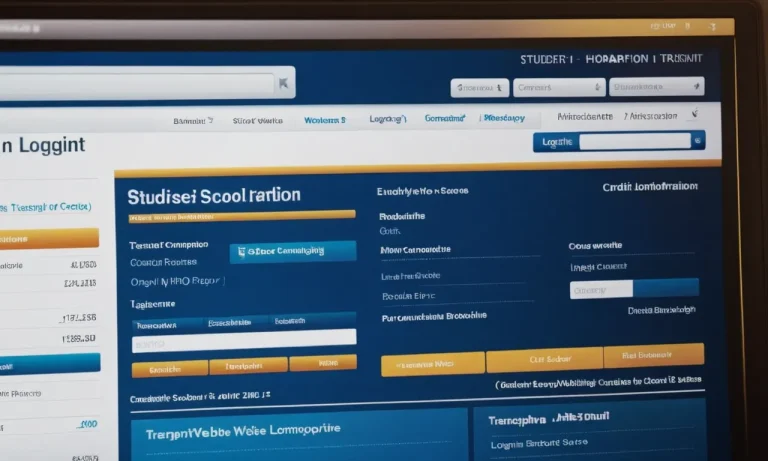Skipping school or walking out of class has been a temptation for many students, but the consequences can be severe. Whether it’s due to personal reasons, protests, or simply a desire for freedom, the decision to leave school premises during school hours raises legal concerns.
If you’re short on time, here’s a quick answer to your question: Walking out of school during school hours without a valid excuse or permission is generally considered truancy, which is illegal in most states and can result in fines, disciplinary actions, or even legal consequences for both students and parents.
In this comprehensive article, we’ll explore the legalities surrounding walking out of school, the potential consequences, and the exceptions that may apply. We’ll also delve into the reasons why students might consider leaving school premises and provide insights into alternative solutions.
Understanding Truancy Laws and Regulations
Definition of truancy
Truancy, also known as skipping school or being absent without a valid excuse, refers to a student’s unauthorized absence from school during regular school hours. It’s a violation of compulsory education laws that require children to attend school until a certain age, typically 16 or 18, depending on the state.
Truancy can have serious consequences for both students and their families, so it’s crucial to understand the laws and regulations surrounding this issue.
State-specific truancy laws
Truancy laws vary from state to state, but generally, they define the number of absences that constitute truancy and outline the procedures schools must follow to address the issue. For example, in California, a student is considered truant after missing more than 30 minutes of instruction without a valid excuse on three occasions in one school year https://www.cde.ca.gov/ls/ai/tr/.
In Texas, a student is considered truant after missing 10 or more days or parts of days within a six-month period in the same school year https://tea.texas.gov/texas-schools/support-for-at-risk-schools-and-students/attendance-and-truancy.
Compulsory education requirements
Compulsory education laws require children to attend school until a certain age, typically 16 or 18, depending on the state. These laws are designed to ensure that all children receive a basic education and are prepared for future success.
According to the Education Commission of the States, as of 2021, 24 states and the District of Columbia require students to attend school until age 18, while the remaining states have compulsory attendance ages ranging from 16 to 17 https://reports.ecs.org/comparisons/ages-of-compulsory-school-attendance-01.
Failure to comply with these laws can result in penalties for both students and their parents or guardians.
Penalties for truancy
The penalties for truancy can vary significantly depending on the state and the severity of the offense. In general, schools will initially attempt to address truancy through interventions such as parent meetings, counseling, or attendance improvement plans.
However, if truancy persists, more serious consequences may follow. For example, in some states, parents or guardians can face fines or even jail time for their child’s excessive absences. In other cases, students may be required to attend truancy court or be placed in alternative education programs.
Ultimately, the goal of these penalties is to encourage students to attend school regularly and avoid the negative consequences associated with truancy, such as falling behind academically, engaging in delinquent behavior, or dropping out of school entirely.
Reasons Why Students Walk Out of School
There are various reasons why students may choose to walk out of school, ranging from personal circumstances to broader social or political issues. It’s crucial to understand these motivations to address the underlying concerns and support students effectively.
Here are some common reasons why students walk out of school:
Personal or family issues
Sometimes, students face personal or family challenges that can significantly impact their ability to attend school. These issues may include financial difficulties, family emergencies, or domestic problems.
In such cases, walking out of school may be a coping mechanism or a necessary step to address the situation at hand. According to a study by the National Center for Education Statistics, approximately 7% of high school students reported missing school due to personal or family reasons in the past month.
Protests or demonstrations
Students may walk out of school as a form of protest or demonstration against specific policies, practices, or social issues. These walkouts can be organized to raise awareness, advocate for change, or express solidarity with a particular cause.
Recent examples include walkouts in support of gun control legislation (as reported by The New York Times) and protests against racial injustice (as covered by Education Week). These walkouts can be powerful expressions of student activism and can sometimes lead to policy changes or increased public awareness.
Mental health concerns
Mental health issues, such as anxiety, depression, or stress, can make it challenging for students to attend school regularly. In some cases, students may walk out of school as a way to cope with overwhelming emotions or to seek support.
According to the Youth Risk Behavior Survey conducted by the Centers for Disease Control and Prevention (CDC), approximately 37% of high school students reported feeling persistent sadness or hopelessness in 2021.
It’s crucial for schools to provide mental health resources and support systems to address these concerns proactively.
Bullying or safety concerns
Unfortunately, bullying and safety concerns can also lead students to walk out of school. If a student feels threatened, harassed, or unsafe in the school environment, they may choose to leave as a means of self-protection or to avoid further harm.
According to StopBullying.gov, a website managed by the U.S. Department of Health and Human Services, approximately one in five students aged 12-18 reported being bullied at school during the 2019 school year.
It’s crucial for schools to implement comprehensive anti-bullying policies and create a safe and inclusive environment for all students.
Regardless of the reason, it’s important for schools, families, and communities to work together to address the underlying issues and support students in their educational journey. By fostering open communication, providing resources, and promoting a positive school climate, we can help ensure that students feel safe, supported, and motivated to attend school.
Potential Consequences of Walking Out of School
Disciplinary actions by the school
Walking out of school without permission can result in disciplinary actions from the school administration. The severity of the consequences often depends on the school’s policies and the circumstances surrounding the walkout.
Common disciplinary measures include detention, suspension, or even expulsion in extreme cases. According to a survey by the National Center for Education Statistics, around 35% of public schools reported cases of student walkouts or protests in the 2017-2018 academic year. Schools typically take a firm stance against walkouts as they disrupt the educational environment and can pose safety concerns.
Legal consequences for students and parents
In some states, walking out of school can have legal implications for both students and their parents. Depending on the laws in your state, students who leave school premises without authorization may be considered truant, which can lead to fines or even criminal charges for the parents.
For example, in Texas, parents can face fines of up to $500 if their child has unexcused absences. It’s crucial to familiarize yourself with your state’s truancy laws and the potential legal consequences of walking out of school.
Impact on academic performance and records
Participating in a school walkout can negatively impact a student’s academic performance and records. Missing class time can result in falling behind on coursework, assignments, and exams. This can ultimately lead to lower grades and potentially affect a student’s overall academic standing.
Additionally, disciplinary actions like suspensions or expulsions can create gaps in a student’s academic record, which may raise concerns for future educational opportunities or employment prospects.
It’s essential for students to weigh the potential academic consequences before deciding to walk out of school.
Long-term effects on future opportunities
The consequences of walking out of school can extend beyond the immediate disciplinary actions and academic impact. A record of disciplinary infractions or poor academic performance can potentially hinder a student’s chances of getting into their desired college or university.
It can also affect their eligibility for scholarships, internships, or other educational opportunities. Furthermore, some employers may view a history of school walkouts or disciplinary issues as a red flag during the hiring process.
While the long-term effects may vary, it’s crucial for students to consider how their actions today can shape their future prospects.
Remember, while walking out of school may seem like a powerful statement, it’s essential to weigh the potential consequences carefully. Exploring alternative means of expression, such as peaceful protests or discussions with school authorities, could be a safer and more constructive approach. 😊
Exceptions and Legitimate Reasons for Leaving School
While unauthorized absences from school are generally considered truancy, there are certain exceptions and legitimate reasons that allow students to leave campus during school hours. Understanding these exceptions is crucial for students, parents, and school administrators to ensure compliance with attendance policies and maintain a safe learning environment.
Medical emergencies or appointments
Students may be permitted to leave school for medical emergencies or scheduled appointments with healthcare providers. In such cases, parents or guardians are typically required to provide written or verbal notification to the school.
Some schools may request documentation from the medical facility to verify the appointment. According to the Centers for Disease Control and Prevention (CDC), approximately 15% of students miss school due to illness or injury each year.
Religious observances
Many schools accommodate students’ religious beliefs and allow them to be excused for observances or holidays. This practice is often protected by state and federal laws, such as the U.S. Department of Education’s guidance on religious expression in public schools.
Schools may require prior notification from parents or guardians to ensure proper documentation.
School-approved activities or field trips
Students participating in school-sponsored activities, such as field trips, athletic events, or academic competitions, are typically excused from regular classes. These absences are considered legitimate and are often pre-arranged with teachers and administrators.
According to a study by the National Center for Education Statistics, approximately 90% of schools offer field trips as part of their educational programs.
Parental consent and proper procedures
In some cases, parents or guardians may request their child’s early dismissal from school for personal reasons, such as family emergencies or special events. Most schools have established procedures for this, which may include providing a written note, signing out the student at the office, or following a specific protocol.
It’s important for parents to follow these procedures to ensure the safety and accountability of their children. According to a 2019 report by the National Center for Education Statistics, around 20% of public schools reported having a strict policy for early dismissals.
It’s worth noting that while these exceptions exist, unauthorized absences or leaving school without proper permission can have consequences, such as disciplinary action or legal implications in some cases.
It’s always advisable to consult with school administrators and follow the established policies and procedures to ensure compliance and maintain a safe learning environment for all students.
Conclusion
Walking out of school during school hours without a valid excuse or permission can have serious legal and academic consequences. While there may be legitimate reasons for leaving school premises, it’s crucial to follow proper procedures and obtain necessary approvals.
If you or your child is facing personal, academic, or safety concerns that may lead to the temptation of walking out, it’s essential to communicate openly with school authorities and seek appropriate support.
By understanding the laws, potential consequences, and available resources, you can make informed decisions and explore alternative solutions that prioritize your well-being and education.






